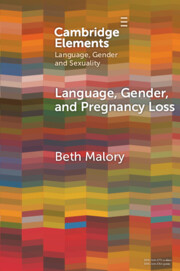Refine search
Actions for selected content:
39 results
19 - Historical Sociolinguistics
- from Part III - The Long View by Levels and Areas
-
-
- Book:
- The New Cambridge History of the English Language
- Published online:
- 30 October 2025
- Print publication:
- 30 October 2025, pp 720-790
-
- Chapter
- Export citation

Language, Gender and Pregnancy Loss
-
- Published online:
- 21 October 2025
- Print publication:
- 13 November 2025
-
- Element
-
- You have access
- Open access
- HTML
- Export citation
An ethnolinguistic approach to contact onomastics: the case of the Falkland Islands’ gaucho place names
-
- Journal:
- Journal of Linguistic Geography / Volume 13 / Issue 1 / April 2025
- Published online by Cambridge University Press:
- 08 September 2025, pp. 45-56
-
- Article
-
- You have access
- Open access
- HTML
- Export citation
The Kongish phenomenon: User perception and language identity
-
- Journal:
- English Today , First View
- Published online by Cambridge University Press:
- 04 July 2025, pp. 1-10
-
- Article
-
- You have access
- Open access
- HTML
- Export citation
Modeling monolingual and bilingual children’s language attitudes towards variation in metropolitan France
-
- Journal:
- Journal of Child Language , First View
- Published online by Cambridge University Press:
- 07 April 2025, pp. 1-27
-
- Article
-
- You have access
- Open access
- HTML
- Export citation
Investigating attitudes towards a changing use of anglicisms in Quebec French
-
- Journal:
- Canadian Journal of Linguistics/Revue canadienne de linguistique / Volume 69 / Issue 4 / December 2024
- Published online by Cambridge University Press:
- 18 February 2025, pp. 412-437
-
- Article
-
- You have access
- Open access
- HTML
- Export citation
7 - Labeling Ethnolects
- from Part II - Activism in the Lecture Hall and the School System
-
-
- Book:
- Language Activism
- Published online:
- 31 May 2025
- Print publication:
- 06 February 2025, pp 93-106
-
- Chapter
- Export citation
Teaching language attitudes through digital storytelling projects
-
- Journal:
- Canadian Journal of Linguistics/Revue canadienne de linguistique / Volume 69 / Issue 3 / September 2024
- Published online by Cambridge University Press:
- 16 December 2024, pp. 333-354
-
- Article
-
- You have access
- Open access
- HTML
- Export citation
8 - Questionnaire Development and Analysis in EMI Research
- from Part II - Empirical Chapters (Case Studies)
-
-
- Book:
- Researching English Medium Instruction
- Published online:
- 14 December 2024
- Print publication:
- 05 December 2024, pp 134-149
-
- Chapter
- Export citation
3 - Sociolinguistic Approaches to Bilingual Phonetics and Phonology
- from Part I - Approaches to Bilingual Phonetics and Phonology
-
-
- Book:
- The Cambridge Handbook of Bilingual Phonetics and Phonology
- Published online:
- 14 November 2024
- Print publication:
- 21 November 2024, pp 65-85
-
- Chapter
- Export citation
21 - Multicultural London English
- from Part IV - Multilingualism: The Development of Urban Contact Varieties
-
-
- Book:
- Language in Britain and Ireland
- Published online:
- 17 October 2024
- Print publication:
- 31 October 2024, pp 455-470
-
- Chapter
- Export citation
Chapter 19 - Attitudes Toward “The Dictionary”
- from Part III - Dictionaries and Ideology
-
-
- Book:
- The Cambridge Handbook of the Dictionary
- Published online:
- 19 October 2024
- Print publication:
- 31 October 2024, pp 385-406
-
- Chapter
- Export citation
6 - Scots and Scottish Standard English
- from Part I - English
-
-
- Book:
- Language in Britain and Ireland
- Published online:
- 17 October 2024
- Print publication:
- 31 October 2024, pp 151-177
-
- Chapter
- Export citation
Dialect change and language attitudes in Albania
-
- Journal:
- Language Variation and Change / Volume 36 / Issue 2 / July 2024
- Published online by Cambridge University Press:
- 18 September 2024, pp. 219-242
-
- Article
-
- You have access
- Open access
- HTML
- Export citation
3 - The Toronto Context
-
- Book:
- Heritage Languages
- Published online:
- 09 July 2024
- Print publication:
- 27 June 2024, pp 29-36
-
- Chapter
- Export citation
3 - Emphasizing the Local in Language Policy
-
- Book:
- Making English Official
- Published online:
- 04 January 2024
- Print publication:
- 18 January 2024, pp 89-111
-
- Chapter
-
- You have access
- Open access
- HTML
- Export citation
3 - Language Shift, Attitudes and Management in the Roman West
-
-
- Book:
- Multilingualism and History
- Published online:
- 20 April 2023
- Print publication:
- 27 April 2023, pp 71-89
-
- Chapter
- Export citation
7 - Multilingualism and Identity in Ningbo, China
- from Part I - Situated Multilingualism and Identity
-
-
- Book:
- Multilingualism and Identity
- Published online:
- 22 July 2022
- Print publication:
- 04 August 2022, pp 131-152
-
- Chapter
- Export citation
16 - Young Children’s Language Attitudes with Implications for Identity in a US Dual-Language Immersion Classroom
- from Part III - Multilingual Identity and Investment
-
-
- Book:
- Multilingualism and Identity
- Published online:
- 22 July 2022
- Print publication:
- 04 August 2022, pp 321-340
-
- Chapter
- Export citation
2 - Discourse Analysis of Print Media
- from Part 1 - Analysis of the Societal Treatment of Language
-
-
- Book:
- Research Methods in Language Attitudes
- Published online:
- 25 June 2022
- Print publication:
- 07 July 2022, pp 19-34
-
- Chapter
- Export citation
